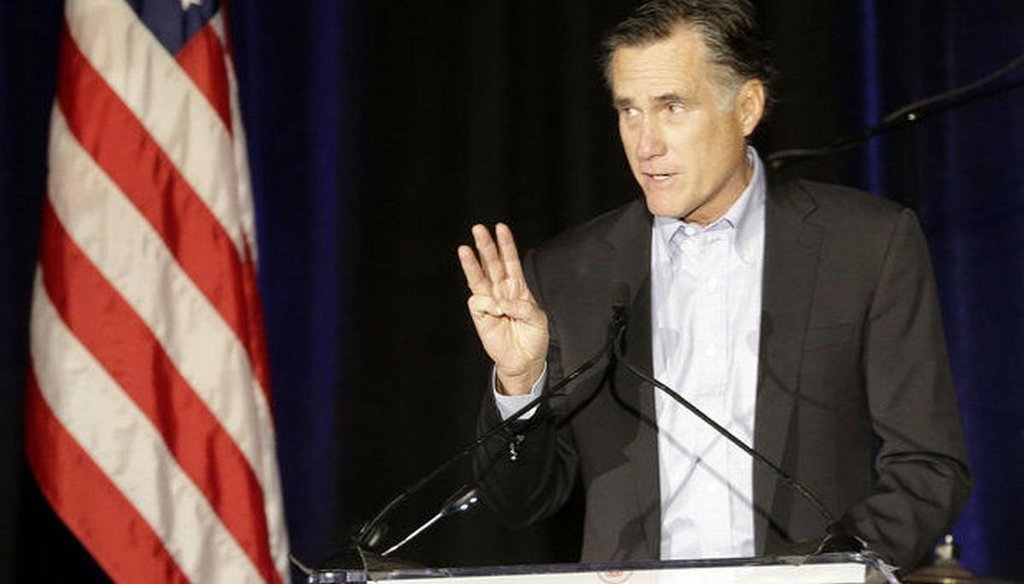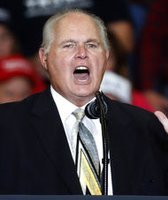Get PolitiFact in your inbox.

Mitt Romney deepened speculation about a possible third run for the presidency in a winter meeting of the Republican National Committee in San Diego on Jan. 16. AP photo.
The Sunday news shows had a ring of 2012, with President Barack Obama and his presidential foe Mitt Romney both grabbing headlines for their intentions to boost the country’s middle class.
Help fund PolitiFact’s Kickstarter to live fact-check the 2015 State of the Union and GOP response.
Obama will use Tuesday’s State of the Union address to call for raising taxes on the country’s wealthiest Americans and biggest financial institutions in order to pay for middle-class tax cuts and other initiatives -- plans that pundits said Sunday will go nowhere with the new Republican-led Congress. Romney, on the other hand, announced he is seriously considering a third run for the presidency, listing income inequality as one of the country’s problems in a Friday meeting with GOP leaders.
In a panel discussion on ABC’s This Week, former Gov. Jennifer Granholm, D-Mich., questioned whether Romney was making a sincere point or just trying to get past his image as the rich guy caught dissing the 47 percent of Americans on government assistance during the 2012 election cycle.
"Listen, when he stands in front of all these Republicans on Friday night and laments the fact that the rich have gotten richer under Barack Obama when, you know, he pays less tax than the guys who installed his car elevators, there is an authenticity problem," Granholm said.
Her talking point rates Half True.
Granholm, who did not return our request for comment, is referring to a small but unwelcome bit from the last presidential election that did not help to soften Romney’s image as a corporate raider. (And we assume she is talking about tax rates, not tax amounts.) In the spring of 2012, the public learned that Romney’s plans for a multi-million dollar beach house in La Jolla, Calif., included an elevator to move cars from the basement to street level. Construction on the site is under way, and we don’t know if the elevators, estimated to cost $55,000, are done yet.
Still, Granholm’s claim hits on a big theme of the 2012 election about the tax code’s differential treatment of income from work and income from investments. Above a certain point, income from work is taxed at a higher rate than income from the stock market. Billionaire Warren Buffett distilled this down to the line that he paid a lower tax rate than his secretary thanks to the favorable treatment of capital gains.
Romney made about $22 million a year and paid millions in taxes both years. From the Bureau of Labor Statistics, we see that in the San Diego metro area, the average elevator installer earned $83,460 in 2013.
After much pressure, Romney released two years of income tax returns in 2012 that showed he paid 13.9 percent in federal taxes in 2010 and 15.3 percent in 2011, a bit less than the national average. While we don’t have all the details on his tax bills, these are the best numbers we have.
Assessing whether the men who installed the elevators paid more in taxes than Romney is difficult. It depends on a number of factors, including the installer’s family situation.
If the installers were single with no children, then a simple tax calculator gives them a total effective federal income tax rate of 17 percent -- more than Romney. If they were married and had a child, and had no other income, the rate would fall to 8.4 percent -- less.
On Fox News Sunday, Family Research Council president Tony Perkins faced off against former U.S. solicitor general and Republican attorney Ted Olson about the U.S. Supreme Court’s decision to take up same-sex marriage this year.
Olson said, "The U.S. Supreme Court 15 times over the last 120 years has said that ‘marriage is a fundamental right.’ "
Perkins cut in, "Marriage, but not same-sex marriage."
"Never once in any of those cases did it say that it had to be between a man and a woman," Olson said. "Fifteen times it said it was a matter of privacy, liberty, association, dignity and respect for the individual."
Olson’s claim rates True.
Olson pointed us to a brief he and his colleagues filed as the respondents in the 2013 case Hollingsworth vs. Perry, which the Supreme Court declined to hear, effectively sustaining a lower court decision to allow same-sex marriages in California.
The brief says the Supreme Court has said marriage is a "fundamental right" in more than a dozen cases. "In fact, this Court has characterized the right to marry as one of the most fundamental rights — if not the most fundamental right — of an individual," the brief said of Loving vs. Virginia, in which the Supreme Court approved interracial marriage.
The cases he cited cover a range of topics, including privacy and parental and reproductive rights, and span from 1888 to 2003, but all touch on marriage as a "fundamental right" in some way.
Experts said the cases support Olson’s claim and that there are likely more than just 15 examples.
The question was never asked until the Supreme Court’s 2013 decision to strike down part of the Defense of Marriage Act, ensuring same-sex couples get the same federal benefits as heterosexual couples, said Clifford Rosky, a law professor at the University of Utah. In this case, the court had to address the definition of marriage and said homosexual couples can be considered married.
Until recent decades, some experts told us, the court likely assumed that when they said "marriage," others would interpret that as meaning a heterosexual union, not a homosexual one, due to societal norms.
This does not change, however, the literal truth of Olson’s claim.
Our Sources
See fact-checks.


















































